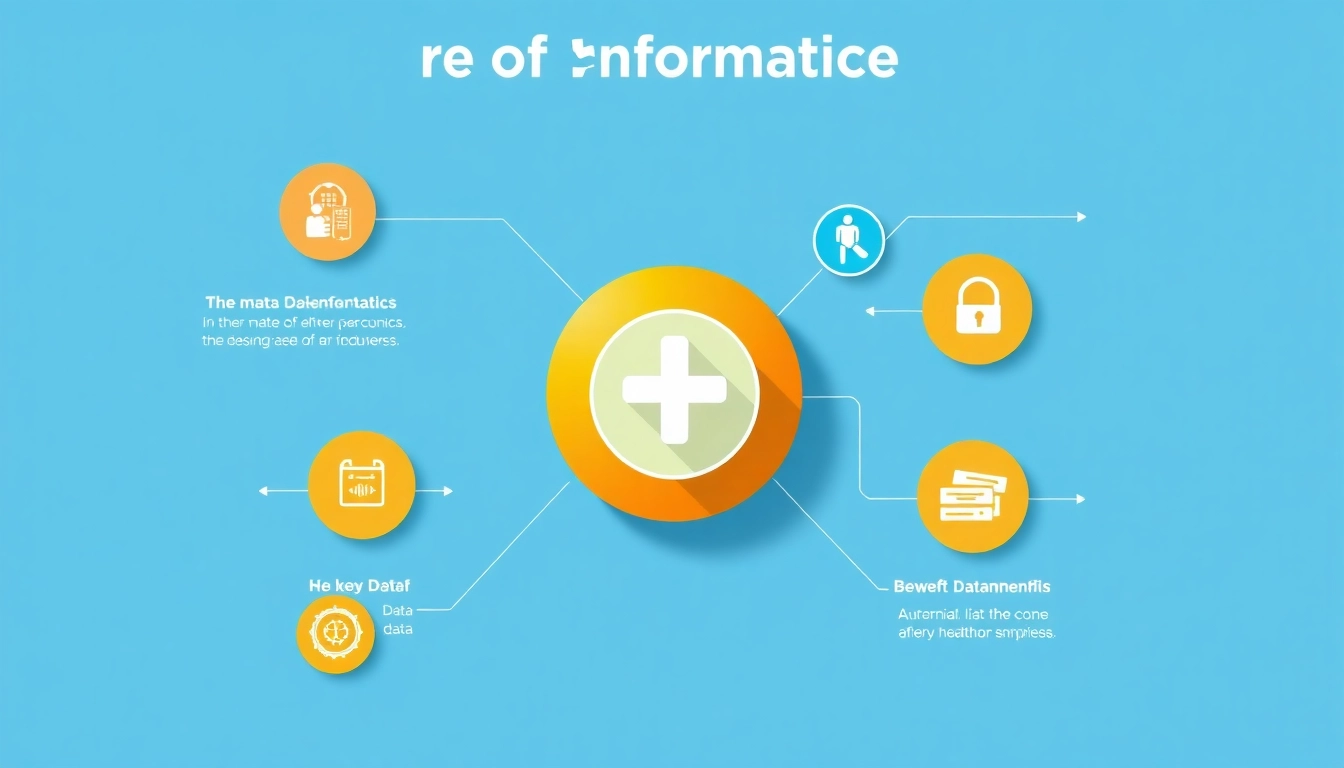1. Introduction to Informatics in Healthcare
Informatics has emerged as a pivotal field within healthcare, aiming to improve patient outcomes through the strategic use of data and technology. As healthcare systems face numerous challenges, informatics provides the tools necessary for effective decision-making, streamlined workflows, and enhanced patient care. At the core of this transformation is the effective integration of data analytics, communication infrastructure, and technology-enhanced processes. Resources such as informaticsview.com offer valuable insights into how informatics can bridge the gap between traditional medical practices and innovative technology.
1.1 What is Informatics?
Informatics is an interdisciplinary field that merges data science, information technology, and healthcare to enhance patient care and outcomes. It encompasses the study of how data can be structured, analyzed, shared, and utilized effectively within clinical environments. At its core, informatics involves the collection of health-related data, its integration into useful formats, and the transformation of this data into actionable knowledge that drives clinical, managerial, and research outcomes.
The scope of informatics goes beyond patient records management; it involves various dimensions such as bioinformatics, nursing informatics, and public health informatics, each targeting specific areas of health and science to facilitate improved health interventions and population health management.
1.2 Importance of Informatics in Modern Healthcare
As the healthcare landscape evolves with emerging technologies and data deluge, informatics plays a crucial role in fostering a more systematic approach to healthcare delivery. Its importance can be understood through several key contributions:
- Improving Patient Safety: Informatics tools enable healthcare providers to reduce medical errors, enhance clinical decision-making, and ensure adherence to evidence-based guidelines.
- Enhancing Efficiency: By automating routine tasks and streamlining communication among providers, informatics solutions lead to quicker triage, reduced wait times, and improved patient experience.
- Facilitating Patient Engagement: Informatics supports patient-centered care by allowing patients to access their health data, communicate with providers, and partake in their own care management through tools like patient portals.
- Driving Research and Insight: The integration of informatics in healthcare facilitates data-driven research and population health management, thereby informing policy decisions and improving overall public health.
1.3 Overview of informaticsview.com Services
InformaticsView.com serves as a comprehensive hub for healthcare professionals looking to enhance their understanding and application of informatics in various healthcare settings. The website offers resources, case studies, and articles tailored to informatics best practices, emerging trends, and practical solutions to common challenges faced in implementing informatics strategies.
From articles that cover the latest innovations in health technology to training resources for healthcare staff looking to leverage informatics solutions effectively, InformaticsView is at the forefront of promoting better health outcomes through information technology.
2. Key Applications of Informatics
The applications of informatics in healthcare are profound and multifaceted, fostering innovation and facilitating quality improvement initiatives across the spectrum of care delivery. Key applications include:
2.1 Electronic Health Records (EHRs)
Electronic Health Records (EHRs) represent one of the most significant advancements in healthcare informatics. These digital files allow for the seamless sharing of patient data among authorized team members, addressing common challenges such as lost patient records.
EHRs enhance clinical documentation by:
- Improving Accessibility: Healthcare teams can easily access up-to-date patient information, leading to faster decision-making and improved care coordination.
- Facilitating Better Health Decisions: EHRs support clinical decision support systems (CDSS) that provide evidence-based recommendations, prompting the best possible treatment choices.
- Streamlining Billing and Scheduling: Automated processes reduce administrative tasks for clinicians, enabling more time for patient care.
Overall, the adoption of EHR systems is crucial for advancing healthcare delivery efficiency and effectiveness.
2.2 Telemedicine Innovations
Telemedicine has grown exponentially, particularly in response to the COVID-19 pandemic, demonstrating its vital role in connecting patients and providers through digital channels. This innovative approach allows for remote consultations, enhanced access to specialists, and ongoing management of chronic conditions from home.
Key aspects of telemedicine include:
- Improving Access to Care: Telemedicine reduces geographical barriers, ensuring that patients in underserved communities receive timely medical attention.
- Cost-Effectiveness: Virtual visits can often be more cost-effective than traditional in-person appointments, resulting in reduced travel expenses and time savings for both patients and healthcare providers.
As telemedicine continues to evolve, the integration of artificial intelligence and predictive analytics will likely provide even more personalized and anticipatory care models.
2.3 Clinical Decision Support Systems (CDSS)
Clinical Decision Support Systems (CDSS) are critical informatics tools designed to aid healthcare professionals in making informed clinical decisions by analyzing patient data and existing clinical knowledge effectively. These systems utilize artificial intelligence to provide real-time assistance during clinical encounters.
The advantages of CDSS include:
- Enhanced Diagnostic Accuracy: By analyzing patient history, lab results, and current clinical guidelines, CDSS can recommend potential diagnoses, improving diagnostic accuracy.
- Personalized Treatment Recommendations: Tailored treatment plans based on individual patient data can be developed, leading to improved outcomes.
With their ability to synthesize vast amounts of information quickly and accurately, CDSS solutions stand at the forefront of precision medicine.
3. Challenges in Implementing Informatics Solutions
While the benefits of informatics in healthcare are extensive, implementing these solutions presents several challenges that healthcare organizations must navigate. These challenges include:
3.1 Data Privacy and Security Concerns
Data privacy and security are paramount in the healthcare industry, particularly as medical data breaches continue to permeate headlines. The sensitive nature of health data necessitates robust security measures to protect patient information from unauthorized access and potential exploitation.
To address these concerns, organizations must:
- Invest in comprehensive security frameworks that comply with regulations such as HIPAA.
- Provide ongoing training to staff about data handling and cybersecurity protocols.
By prioritizing data security, healthcare organizations can help build trust with patients and decrease the likelihood of data breaches.
3.2 Integration with Existing Healthcare Systems
Integrating new informatics solutions into existing healthcare systems represents a significant challenge. Many legacy systems lack interoperability, complicating data sharing between disparate platforms.
To facilitate successful integration, healthcare organizations should:
- Conduct thorough assessments of existing systems and identify compatibility issues.
- Adopt standardized data formats to ensure seamless data exchange.
Successful integration is crucial for maximizing the utility of informatics systems and realizing their full potential.
3.3 Resistance to Change Among Healthcare Personnel
Resistance to change is a common barrier when implementing new informatics solutions. Healthcare personnel may feel threatened by new technologies or hesitant to abandon established practices.
Strategies to overcome resistance include:
- Engaging stakeholders early in the implementation process to solicit feedback and address concerns.
- Providing comprehensive training and demonstrating the practical benefits of informatics solutions in improving clinical workflows.
Building a culture that embraces change can foster greater acceptance and promote a more innovative mindset among healthcare professionals.
4. Best Practices for Effective Informatics Management
Successfully managing informatics initiatives requires adherence to proven best practices that foster both team alignment and optimal technological utilization. Key practices include:
4.1 Training and Education of Staff
The successful implementation of informatics solutions relies heavily on the competency of the personnel using the technologies. Continuous training and skill development are essential to ensure staff can utilize informatics systems effectively.
Organizations should:
- Invest in onboarding programs for new staff focused on informatics systems.
- Implement ongoing training workshops to address new features and functionalities of informatics tools.
Well-trained staff leads to more efficient operations and improved patient outcomes.
4.2 Continuous Feedback Mechanisms
Establishing continuous feedback mechanisms enables healthcare organizations to assess the effectiveness of their informatics systems actively. By soliciting input from users, organizations can identify areas for improvement and adjust workflows swiftly.
Organizations can achieve this by:
- Utilizing surveys and formal feedback programs to gauge user satisfaction.
- Establishing regular review meetings to discuss system performance and gather suggestions for enhancements.
By fostering an environment that encourages open feedback, organizations can continually enhance their informatics practices.
4.3 Evaluating Informatics Performance Metrics
Setting clear performance metrics is crucial for measuring the success of informatics implementations. Healthcare organizations should establish KPIs that align with operational goals, such as:
- User adoption rates of new systems.
- Improvements in patient outcomes directly related to informatics interventions.
- Efficiency gains derived from streamlined workflows.
Regularly assessing these metrics allows organizations to analyze the return on investment (ROI) of their informatics systems and adjust their strategies accordingly.
5. Future Trends in Healthcare Informatics
The future of healthcare informatics is poised for transformative advancements that will shape how care is delivered. As technology continues to evolve, several trends are emerging that promise to enhance informatics applications further:
5.1 AI and Machine Learning Applications
Artificial Intelligence (AI) and Machine Learning (ML) are at the forefront of informatics innovations, enabling predictive analytics and automated decision-making processes. These technologies are increasingly used to:
- Analyze large datasets efficiently to provide insights into population health trends.
- Enhance diagnostic capabilities by recognizing patterns that would otherwise go undetected.
The application of AI in healthcare will lead to more personalized treatments and proactive interventions, ultimately improving patient care.
5.2 The Role of Big Data
Big Data represents the large volumes of structured and unstructured health data generated within the healthcare ecosystem. Leveraging big data analytics will allow healthcare organizations to:
- Identify correlations that drive better patient outcomes.
- Monitor real-time health trends across diverse demographics.
The ability to harness big data effectively will lead to more informed decision-making, enhanced service delivery, and lower healthcare costs.
5.3 Innovations in Patient Engagement Technologies
Patient engagement technologies are rapidly evolving, providing new ways for patients to participate in their healthcare. Innovations such as mobile health (mHealth) applications and telehealth platforms are enhancing communication between patients and providers, facilitating more robust patient engagement. Key innovations include:
- Wearable devices that track health metrics and facilitate real-time data sharing with healthcare teams.
- Patient education tools that empower individuals to make informed decisions about their care.
As patient engagement technologies advance, they will significantly improve adherence to treatment plans and foster better health outcomes.















Leave a Reply